The NVIDIA GeForce GTX 1070 Ti Founders Edition Review: GP104 Comes in Threes
by Nate Oh on November 2, 2017 9:00 AM EST- Posted in
- GPUs
- GeForce
- NVIDIA
- Pascal
- GTX 1070 Ti
Overclocking
As NVIDIA is pushing the GTX 1070 Ti for overclocking, it is only fair that we look into it. While NVIDIA does support overclocking, they have limited actual overvolting, and instead providing the ability to unlock 1-2 more boost bins and associated voltages. Using Precision XOC, we adjusted the core and memory clocks, as well as the power/temperature limit and percent 'overvoltage.' For the 180W GTX 1070 Ti, the TDP and TDP limit match the GTX 1080, resulting in a 120% power limit (216W). The 1.093v boost voltage is no surprise, matching the GTX 1080 and 1070 FEs.
| GTX 1070 Ti FE Overclocking | ||||
| Stock | Overclocked | |||
| Core Clock | 1607MHz | 1787MHz | ||
| Boost Clock | 1683MHz | 1863MHz | ||
| Max Boost Clock | 1898MHz | 2078MHz | ||
| Memory Clock | 8Gbps | 8.8Gbps | ||
| Max Voltage | 1.062v | 1.093v | ||
The results, of course, cannot be taken as representative of all GTX 1070 Ti Founders Editions, as this is only a sampled sample size of one. But results here can offer some insight. For one, if there were explicit actual overvolting, it seems very possible to stabilize ~2100+MHz clocks on the GTX 1070 Ti Founders Edition. At any rate, GPU overclocks topped out with observed clocks in the high 2000MHz region, roughly 10% over the previously measured average in-game clockspeeds. Memory overclocks were only able to go up 200MHz from the base 2002MHz, or also about 10%. All-in-all, very similar to the GTX 1070 FE, which also managed 10% overclocks on both GPU and GDDR5 memory. Recalling that the GTX 1070 Ti FE clocked on average just 2% higher than the GTX 1070 FE at stock, there's nothing particularly groundbreaking here, especially considering the 20-25% overclock capability of Maxwell 2 reference cards.
A total of four different overclocks were tested. First was a baseline, consisting of 100% overvoltage and max power/temperature limits. The second was overclocking the GDDR5 memory by 800Mbps. The third was overclocking the GPU with a +180MHz offset; in practice this resulted in observed clocks between 2030 - 2080MHz. Lastly, all previous adjustments were combined for an overall overclock.
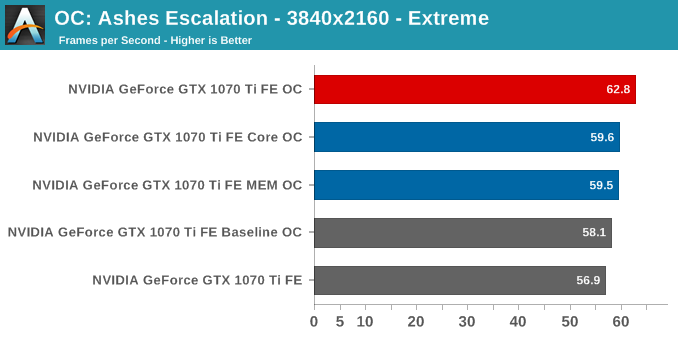
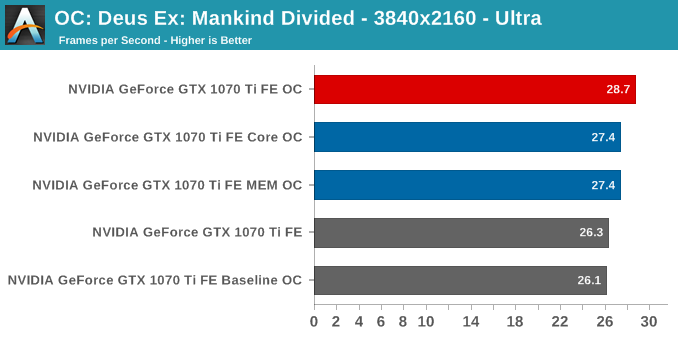
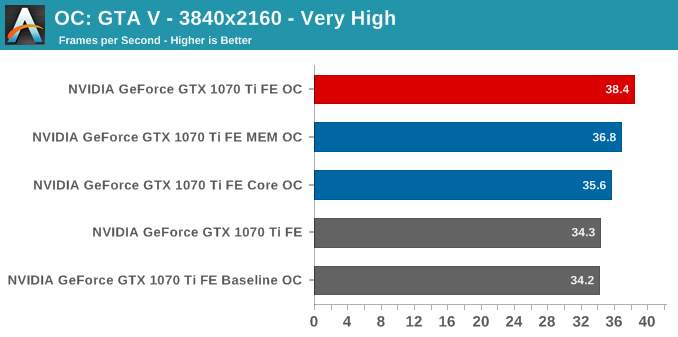
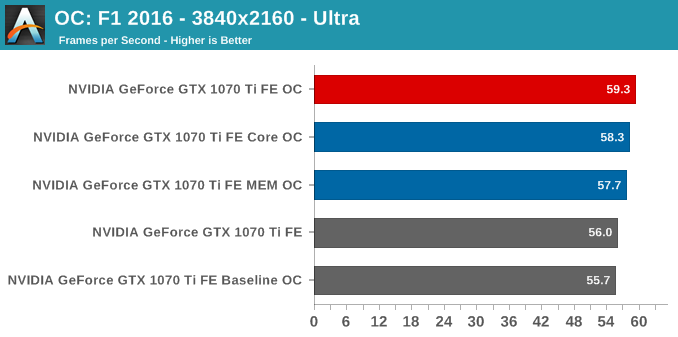
Although this is more of a cursory look than anything else, the combined overclock provides the best performance, just like it was for the GTX 1080 and 1070, although it seems like memory overclocking is more effective on the GTX 1070 Ti. Earlier, we mentioned how the GTX 1070 Ti compared to the GTX 1070 by having four more SMs but without any additional memory bandwidth, and perhaps that is playing a role here.
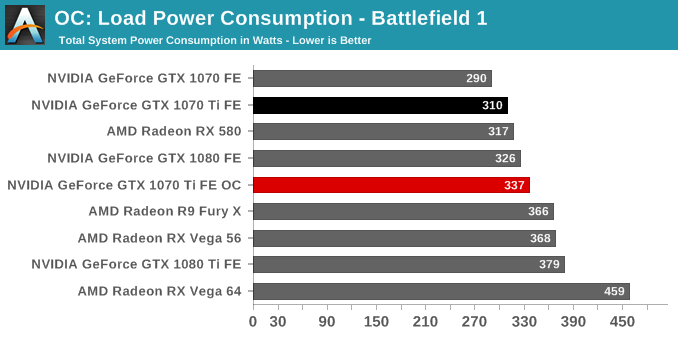
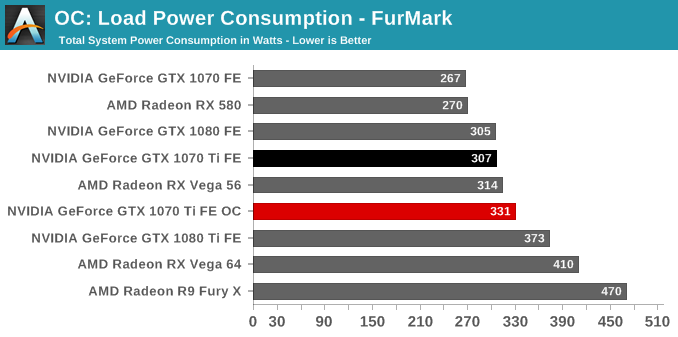
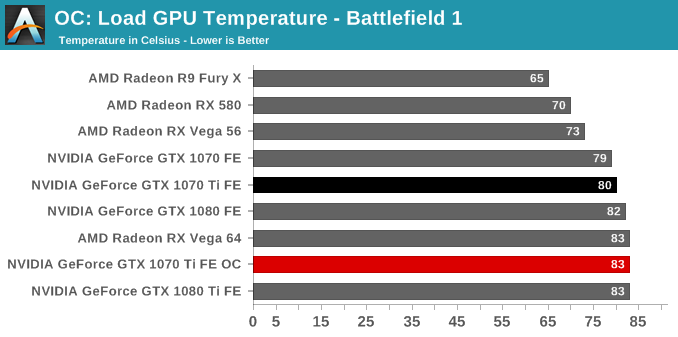
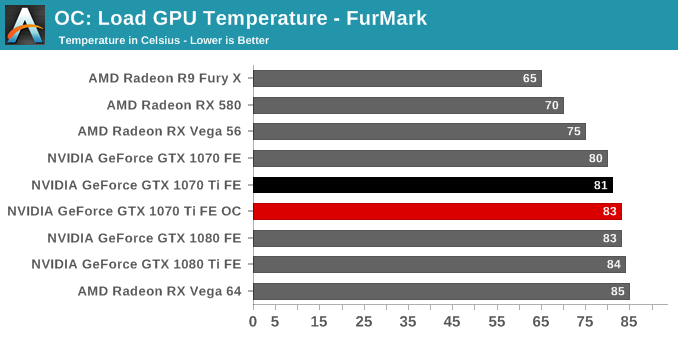
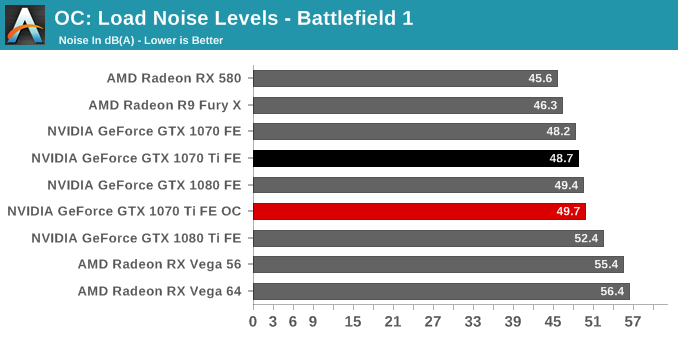
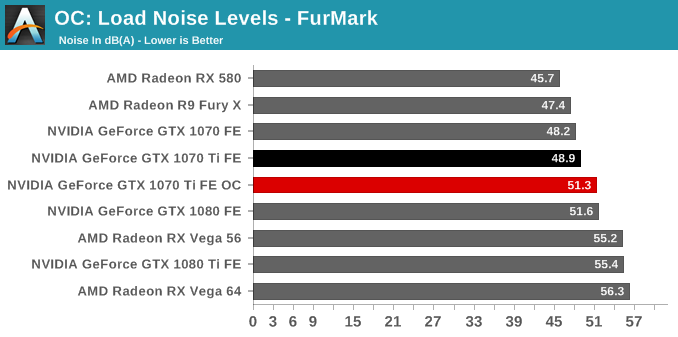
There isn't much to add on the power, temperature, and noise front. Understandably, the card will heat up a few more degrees and spin its blower faster, at the expense of ~25W at the wall, inasmuch as the 120% power limit will let it. As a casual overclocker, there may not be a lot to gain here; the GTX 1070 Ti FE already boosts to ~1800+MHz at stock, and squeezing 200MHz more with the anemic capabilities of NVIDIA's reference PCB won't make waves. And for hardcore overclockers, there would be little need of the reference board's power delivery system.










78 Comments
View All Comments
BrokenCrayons - Thursday, November 2, 2017 - link
This review was a really good read. I also like that the game screenshots were dropped from it since they didn't exactly add much, but do eat a little of my data plan when I'm reading from a mobile device.As for the 1070 Ti, agreed its priced a bit too high. However, I think most of the current-gen GPUs are pushing the price envelope right now. Except maybe the 1030 of course which has a reasonable MSRP and doesn't require a dual slot cooler. That's really the only graphics card outside of an iGPU I'd seriously consider if I were in the market at the moment, but then again I'm not playing a lot of games on a PC because I have a console and a phone for that sort of thing.
Communism - Thursday, November 2, 2017 - link
Literally the same price as a 1070 non-Ti was a week ago.Those cards sold so well that retailers are still gouging them to this day.
Communism - Thursday, November 2, 2017 - link
And I should mention that the only reason that retail prices of 1070, Vega 56, and Vega 64 went down is due to the launch of 1070 Ti.timecop1818 - Thursday, November 2, 2017 - link
Still got that fuckin' DVI shit in 2017.DanNeely - Thursday, November 2, 2017 - link
Lack of a good way to run dual link DVI displays via HDMI/DP is probably keeping it around longer than originally intended. This includes both relatively old 2560x1600 displays that predate DP or HDMI 1.4 and thus could only do DL-DVI, and cheap 'Korean' 2560x1440 monitors from 2 or 3 years ago. The basic HDMI/DP-DVI adapters are single link and max out at 1920x1200. A few claim 2560x1600 by overclocking the data rate by 100% to stuff it down a single link worth of wires; this is mostly useless though since other than HDMI1.4 capable displays (which don't need this) virtually no DVI monitors can actually take a signal that fast. Active DP-DLDVI adapters can theoretically do it for $70-100, but they all came out buggy to one degree or another and sales were apparently too low to justify a new generation of hardware that fixed the issues.Nate Oh - Saturday, November 4, 2017 - link
This is actually precisely why I don't mind DVI too much, because I have and still use a 1-DVI-input-only Korean 1440p A- monitor from 3 years ago, overclocked to 96Hz. DVI probably needs to go away at some point soon, but maybe not too soon :)ddferrari - Friday, November 3, 2017 - link
So, that DVI port really ruins everything for ya? What are you, 14??There are tons of overclockable 1440p Korean monitors out there that only have one input- DVI. Adding a DVI port doesn't increase cost, slow down performance, or increase heat levels- so what's your imaginary problem again?
Notmyusualid - Sunday, November 5, 2017 - link
@ ddferrariWhat are you - ddriver incarnate?
I'm older than 14, and I wish the DVI port wasn't' there, as it is work to strip them off when I make my GPUs into single-slot water-cooled versions. Removing / modifying the bracket is one thing, but pulling out those DVI ports is another.
Silma - Thursday, November 2, 2017 - link
How can you compare the Vega 56 to the GTX 1070 when it's 7 dB noisier and consumes up to 78 watts more ?sach1137 - Thursday, November 2, 2017 - link
Because the MSRP's of both the cards are same. Vega 56 beats 1070 in almost all games.yes it consumes more power and noiser too. But for some people it doesnt matter it gives 10-15% more performance than 1070. When Overclocked you can extract more from Vega 56 too.